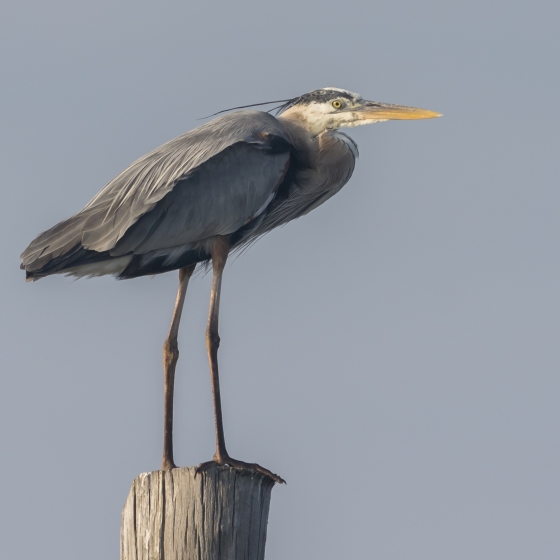Great Blue Heron
Ardea herodias

Introduction
A larger version of our Grey Heron, this is an extremely rare visitor from North America, where it is a very widespread and familiar bird.

Key Stats
Population and distribution stats for:
Status and Trends
Population size, trends and patterns of distribution based on
BTO and partnership surveys and atlasses with data collected by BTO volunteers.
Conservation Status
This species can be found on the following statutory and conservation listings and schedules.
IUCN Red List of Threatened Species (global)
Schedule 1 Licence required (to disturb)*
No
Birds Directive Annex 1
No
* A guide only. Check details with the original legislation, especially those marked with an asterisk.
See About Birdfacts for more information.
Population Size
First Record*
Isles of Scilly 2007
* First documented occurrence. Most species undoubtedly occurred before this.
See About Birdfacts for more information.
Population Change
Population trends of this scarce species are not routinely monitored.
Distribution
This species is a rare vagrant and was recorded during Bird Atlas 2007–11 as shown on the map.
Occupied 10-km squares in UK
These figures come from Bird Atlas 2007 and indicate how widespread a species is.
No. occupied in winter
1
% occupied in winter
0.03%
Bird Atlas distribution maps show where bird species breed or winter in Britain and Ireland.
For breeding maps, larger dots indicate higher certainty the species bred in that area.
Click the map to enlarge,
or view it on Bird Atlas Mapstore.
or view it on Bird Atlas Mapstore.
To view and download up-to-date distribution information aggregated from across BTO
and partnership surveys and schemes, see our data holdings on the
NBN Atlas.
Distribution Change
This vagrant is too rarely reported to map distribution change.
Seasonality
This species has been too rarely reported to BirdTrack during 2011–22 to properly assess seasonality.
Movement
Information about Great Blue Heron movements and migration based on online bird portals (e.g. BirdTrack),
Ringing schemes and tracking studies.
Britain & Ireland movement
View a summary of recoveries in the Online Ringing Report
Biology
Lifecycle and body size information for Great Blue Heron, including statistics on nesting, eggs and lifespan
based on BTO ringing and nest recording data.
Survival and Longevity
Survival is shown as the proportion of birds surviving from one year to the next and is derived from bird ringing data. It can also be used to estimate how long birds typically live.
Classification, names and codes
Taxonomy, names and species codes for Great Blue Heron
Classification and Codes
- Order: Pelecaniformes
- Family: Ardeidae
- Scientific name: Ardea herodias
- Authority: Linnaeus, 1758
- Euring code number: 1230
Alternate species names
- Catalan: bernat americà
- Czech: volavka velká
- Danish: Stor Blåhejre
- Dutch: Amerikaanse Blauwe Reiger
- Estonian: ameerika hallhaigur
- Finnish: amerikanharmaahaikara
- French: Grand Héron
- German: Kanadareiher
- Hungarian: királygém
- Icelandic: Bláhegri
- Italian: Airone azzurro
- Latvian: Kanadas garnis
- Lithuanian: didysis pilkasis garnys
- Norwegian: Herodiashegre
- Polish: czapla modra
- Portuguese: garça-azul-grande / garça-real-americana
- Slovak: volavka statná
- Slovenian: ameriška siva caplja
- Spanish: Garza azulada
- Swedish: amerikansk gråhäger
More Evidence
More evidence from Conservation Evidence.com
Partners
Birdfacts is based on data collected by volunteers participating in surveys that are organised and funded by
BTO,
RSPB,
Esmée Fairbairn Foundation,
JNCC and other partners.
Find a Species

